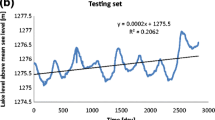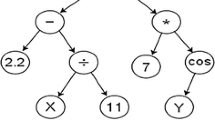Abstract
Seepage prediction is a vital part of the dam safety monitoring system. Traditional statistical models ignore the nonlinear characteristics of the measured variables, resulting in poor accuracy and stability. In this study, an optimized neural network model is constructed to predict the seepage extent of hydropower station dams. An improved gradient-based optimizer (IGBO) is proposed to increase the accuracy and reliability of extreme learning machine (ELM) model predictions. The IGBO introduces an initialization method with elite opposition-based learning to improve population diversity. A crossover operator and a nonlinear parameter are used in the IGBO to enhance the ability of local search and the probability of avoiding local optima. The performance of the IGBO-optimized ELM network (IGBO-ELM) was evaluated on 12 datasets. In addition, the comparison experimental results with actual monitoring data of concrete dams show that IGBO-ELM has strong generalization performance and accuracy among the other four optimization models.












Similar content being viewed by others
References
Cao, E.; Bao, T.; Gu, C.; Li, H.; Liu, Y.; Hu, S.: A novel hybrid decomposition-ensemble prediction model for dam deformation. Appl. Sci. 10(16), 5700 (2020)
Parsaie, A.; Haghiabi, A.H.; Latif, S.D.; Tripathi, R.P.: Predictive modelling of piezometric head and seepage discharge in Earth dam using soft computational models. Environ. Sci. Pollut. Res. 28(43), 60842–60856 (2021)
Ishfaque, M.; Dai, Q.; Jadoon, K.; Shahzad, S.M.; Janjuhah, H.T.: Use of recurrent neural network with long short-term memory for seepage prediction at Tarbela dam, KP, Pakistan. Energies 15(9), 3123 (2022)
Xiong, Z.: Study on seepage analysis model controlled by rainfall. In International Conference on Computer Vision and Pattern Analysis (ICCPA 2021)(Vol. 12158, pp. 199–202). SPIE (2022)
Nourani, V.; Behfar, N.; Dabrowska, D.; Zhang, Y.: The applications of soft computing methods for seepage modeling: a review. Water 13(23), 3384 (2021)
Seyed-Kolbadi, S.M.; Hariri-Ardebili, M.A.; Mirtaheri, M.; Pourkamali-Anaraki, F.: Instrumented health monitoring of an earth dam. Infrastructures 5(3), 26 (2020)
Lin, C.; Li, T.; Chen, S.; Liu, X.; Lin, C.; Liang, S.: Gaussian process regression-based forecasting model of dam deformation. Neural Comput. Appl. 31(12), 8503–8518 (2019)
Bian, K.; Wu, Z.: Data-based model with EMD and a new model selection criterion for dam health monitoring. Eng. Struct. 260, 114171 (2022)
Yu, Y.; Liu, X.; Wang, E.; Fang, K.; Huang, L.: Dam safety evaluation based on multiple linear regression and numerical simulation. Rock Mech. Rock Eng. 51(8), 2451–2467 (2018)
Tatin, M.; Briffaut, M.; Dufour, F.; Simon, A.; Fabre, J.P.: Statistical modelling of thermal displacements for concrete dams: influence of water temperature profile and dam thickness profile. Eng. Struct. 165, 63–75 (2018)
Salazar, F.; Toledo, M.A.; Oñate, E.; Morán, R.: An empirical comparison of machine learning techniques for dam behaviour modelling. Struct. Saf. 56, 9–17 (2015)
Li, B.; Yang, J.; Hu, D.: Dam monitoring data analysis methods: a literature review. Struct. Control. Health Monit. 27(3), e2501 (2020)
Kumar, P.M.; Saravanakumar, R.; Karthick, A.; Mohanavel, V.: Artificial neural network-based output power prediction of grid-connected semitransparent photovoltaic system. Environ. Sci. Pollut. Res. 29, 10173–10182 (2022)
El Bilali, A.; Moukhliss, M.; Taleb, A.; Nafii, A.; Alabjah, B.; Brouziyne, Y.; Mhamed, M.: Predicting daily pore water pressure in embankment dam: empowering machine learning-based modeling. Environ. Sci. Pollut. Res. 29, 47382–47398 (2022)
Ziggah, Y.Y.; Issaka, Y.; Laari, P.B.: Evaluation of different artificial intelligent methods for predicting dam piezometric water level. Model. Earth Syst. Environ. 8(2), 2715–2731 (2022)
Ibrahim, K.S.M.H.; Huang, Y.F.; Ahmed, A.N.; Koo, C.H.; El-Shafie, A.: A review of the hybrid artificial intelligence and optimization modelling of hydrological streamflow forecasting. Alex. Eng. J. 61(1), 279–303 (2022)
Li, Y.; Bao, T.; Gao, Z.; Shu, X.; Zhang, K.; Xie, L.; Zhang, Z.: A new dam structural response estimation paradigm powered by deep learning and transfer learning techniques. Struct. Health Monit. 21(3), 770–787 (2022)
Nguyen-Le, V.; Shin, H.: Artificial neural network prediction models for Montney shale gas production profile based on reservoir and fracture network parameters. Energy 244, 123150 (2022)
Tam, V.W.; Butera, A.; Le, K.N.; da Silva, L.C.; Evangelista, A.C.: A prediction model for compressive strength of CO2 concrete using regression analysis and artificial neural networks. Constr. Build. Mater. 324, 126689 (2022)
Bui, D.T.; Tsangaratos, P.; Nguyen, V.T.; Van Liem, N.; Trinh, P.T.: Comparing the prediction performance of a deep learning neural network model with conventional machine learning models in landslide susceptibility assessment. CATENA 188, 104426 (2020)
Huang, G.B.; Wang, D.H.; Lan, Y.: Extreme learning machines: A survey. Int. J. Mach. Learn. Cybern. 2(2), 107–122 (2011)
Huang, G.B.; Zhu, Q.Y.; Siew, C.K.: Extreme learning machine: Theory and applications. Neurocomputing 70(1–3), 489–501 (2006)
Yaseen, Z.M.; Sulaiman, S.O.; Deo, R.C.; Chau, K.W.: An enhanced extreme learning machine model for river flow forecasting: State-of-the-art, practical applications in water resource engineering area and future research direction. J. Hydrol. 569, 387–408 (2019)
Ali, M.; Prasad, R.: Significant wave height forecasting via an extreme learning machine model integrated with improved complete ensemble empirical mode decomposition. Renew. Sustain. Energy Rev. 104, 281–295 (2019)
Han, Y.; Liu, S.; Cong, D.; Geng, Z.; Fan, J.; Gao, J.; Pan, T.: Resource optimization model using novel extreme learning machine with t-distributed stochastic neighbor embedding: Application to complex industrial processes. Energy 225, 120255 (2021)
Faris, H.; Mirjalili, S.; Aljarah, I.; Mafarja, M.; Heidari, A.A.: Salp swarm algorithm: theory, literature review, and application in extreme learning machines. In: Mirjalili, S., Song Dong, J., Lewis, A. (eds.) Nature-Inspired Optimizers. Studies in Computational Intelligence, vol. 811, pp. 185–199. Springer, Cham (2020)
Gao, Y.; Zhou, Y.; Luo, Q.: An efficient binary equilibrium optimizer algorithm for feature selection. IEEE Access 8, 140936–140963 (2020)
Tang, C.; Zhou, Y.; Tang, Z.; Luo, Q.: Teaching-learning-based pathfinder algorithm for function and engineering optimization problems. Appl. Intell. 51(7), 5040–5066 (2021)
Yang, X.S.: Nature-Inspired Metaheuristic Algorithms. Luniver press, UK (2010)
Mirjalili, S.: Genetic algorithm. In: Evolutionary Algorithms and Neural Networks. Studies in Computational Intelligence, vol. 780, pp. 43–55. Springer, Cham (2019)
Price, K.V.: Differential evolution. In: Zelinka, I., Snášel, V., Abraham, A. (eds.) Handbook of Optimization. Intelligent Systems Reference Library, vol. 38, pp. 187–214. Springer, Berlin, Heidelberg (2013)
Poli, R.; Kennedy, J.; Blackwell, T.: Particle swarm optimization. Swarm Intell. 1(1), 33–57 (2007)
Mirjalili, S.; Lewis, A.: The whale optimization algorithm. Adv. Eng. Softw. 95, 51–67 (2016)
Mirjalili, S.; Mirjalili, S.M.; Lewis, A.: Grey wolf optimizer. Adv. Eng. Softw. 69, 46–61 (2014)
Rashedi, E.; Nezamabadi-Pour, H.; Saryazdi, S.: GSA: a gravitational search algorithm. Inf. Sci. 179(13), 2232–2248 (2009)
Mirjalili, S.: SCA: a sine cosine algorithm for solving optimization problems. Knowl. Based Syst. 96, 120–133 (2016)
Ahmadianfar, I.; Bozorg-Haddad, O.; Chu, X.: Gradient-based optimizer: a new metaheuristic optimization algorithm. Inf. Sci. 540, 131–159 (2020)
Karaboga, D.; Basturk, B.: Artificial bee colony (ABC) optimization algorithm for solving constrained optimization problems. In: Melin, P., Castillo, O., Aguilar, L.T., Kacprzyk, J., Pedrycz, W. (eds.) Foundations of Fuzzy Logic and Soft Computing. IFSA 2007. Lecture Notes in Computer Science, vol. 4529, pp, 789–798. Springer, Berlin (2007)
Fan, C.; Zhou, Y.; Tang, Z.: Neighborhood centroid opposite-based learning Harris Hawks optimization for training neural networks. Evol. Intel. 14(4), 1847–1867 (2021)
Gan, Y.; Meng, B.; Chen, Y.; Sun, F.: An intelligent measurement method of the resonant frequency of ultrasonic scalpel transducers based on PSO-BP neural network. Measurement 190, 110680 (2022)
Aljarah, I.; Faris, H.; Mirjalili, S.: Optimizing connection weights in neural networks using the whale optimization algorithm. Soft. Comput. 22(1), 1–15 (2018)
Li, L.L.; Sun, J.; Tseng, M.L.; Li, Z.G.: Extreme learning machine optimized by whale optimization algorithm using insulated gate bipolar transistor module aging degree evaluation. Expert Syst. Appl. 127, 58–67 (2019)
Shi-fan, Q.; Jun-kun, T.; Yong-gang, Z.; Li-jun, W.; Ming-fei, Z.; Jun, T.; Qing, H.: Settlement prediction of foundation pit excavation based on the GWO-ELM model considering different states of influence. Adv. Civil Eng. 2021, 1 (2021)
Miao, X.Y.; Chu, J.K.; Qiao, J.; Zhang, L.H.: Predicting seepage of earth dams using neural network and genetic algorithm. In Advanced Materials Research Vol. 403, pp. 3081–3085. Trans Tech Publications Ltd. (2012)
Zhang, K.; Gu, C.; Zhu, Y.; Chen, S.; Dai, B.; Li, Y.; Shu, X.: A novel seepage behavior prediction and lag process identification method for concrete dams using HGWO-XGBoost model. IEEE Access 9, 23311–23325 (2021)
Chi, S.; Ni, S.; Liu, Z.: Back analysis of the permeability coefficient of a high core rockfill dam based on a RBF neural network optimized using the PSO algorithm Mathematical Problems in Engineering (2015)
Sherman, A.H.: On Newton-iterative methods for the solution of systems of nonlinear equations. SIAM J. Numer. Anal. 15(4), 755–771 (1978)
Akyol, K.: Comparing of deep neural networks and extreme learning machines based on growing and pruning approach. Expert Syst. Appl. 140, 112875 (2020)
Tizhoosh, H.R.: Opposition-based learning: a new scheme for machine intelligence. In International conference on computational intelligence for modelling, control and automation and international conference on intelligent agents, web technologies and internet commerce (CIMCA-IAWTIC'06) (Vol. 1, pp. 695–701). IEEE (2005)
Zhang, S.; Luo, Q.; Zhou, Y.: Hybrid grey wolf optimizer using elite opposition-based learning strategy and simplex method. Int. J. Comput. Intell. Appl. 16(02), 1750012 (2017)
Kaya, Y.; Uyar, M.: A novel crossover operator for genetic algorithms: ring crossover (2011) arXiv preprint arXiv:1105.0355.
Niu, Y.; Yan, X.; Wang, Y.; Niu, Y. Dynamic opposite learning enhanced artificial ecosystem optimizer for IIR system identification. J. Supercomput. 78, 13040–13085 (2022)
Han, F.; Yao, H.F.; Ling, Q.H.: An improved evolutionary extreme learning machine based on particle swarm optimization. Neurocomputing 116, 87–93 (2013)
Zhang, L.; Qin, Q.; Shang, Y.; Chen, S.; Zhao, S. Application of DE-ELM in analog circuit fault diagnosis. In 2016 Prognostics and System Health Management Conference (PHM-Chengdu) (pp. 1–6). IEEE (2016)
Chao, W.; Khishe, M.; Mohammadi, M.; Karim, S.H.T.; Rashid, T.A.: Evolving deep convolutional neural network by hybrid sine-cosine and extreme learning machine for real-time COVID19 diagnosis from X-ray images (2021) arXiv preprint arXiv:2105.14192
Sang, L.; Wang, J.C.; Sui, J.; Dziedzic, M.: A new approach for dam safety assessment using the extended cloud model. Water Resour. Manag. (2022). https://doi.org/10.1007/s11269-022-03124-1
Chen, S.; Gu, C.; Lin, C.; Wang, Y.; Hariri-Ardebili, M.A.: Prediction, monitoring, and interpretation of dam leakage flow via adaptative kernel extreme learning machine. Measurement 166, 108161 (2020)
Chen, Y.; Zhang, X.; Karimian, H.; Xiao, G.; Huang, J.: A novel framework for prediction of dam deformation based on extreme learning machine and Lévy flight bat algorithm. J. Hydroinf. 23(5), 935–949 (2021)
Acknowledgements
This research is funded by the National Natural Science Foundation of China, Grant number U21A20464, 62066005, and Project of the Guangxi Science and Technology under Grant No. AD21196006.
Author information
Authors and Affiliations
Contributions
LL contributed to conceptualization, methodology, and writing—original draft. YZ contributed to supervision, writing—review and editing. HH contributed to validation, resources, writing—review and editing. QL contributed to validation, writing—review and editing, supervision.
Corresponding author
Ethics declarations
Conflict of interest
The authors declare that they have no known competing financial interests or personal relationships that could have appeared to influence the work reported in this paper.
Rights and permissions
Springer Nature or its licensor holds exclusive rights to this article under a publishing agreement with the author(s) or other rightsholder(s); author self-archiving of the accepted manuscript version of this article is solely governed by the terms of such publishing agreement and applicable law.
About this article
Cite this article
Lei, L., Zhou, Y., Huang, H. et al. Extreme Learning Machine Using Improved Gradient-Based Optimizer for Dam Seepage Prediction. Arab J Sci Eng 48, 9693–9712 (2023). https://doi.org/10.1007/s13369-022-07300-8
Received:
Accepted:
Published:
Issue Date:
DOI: https://doi.org/10.1007/s13369-022-07300-8




